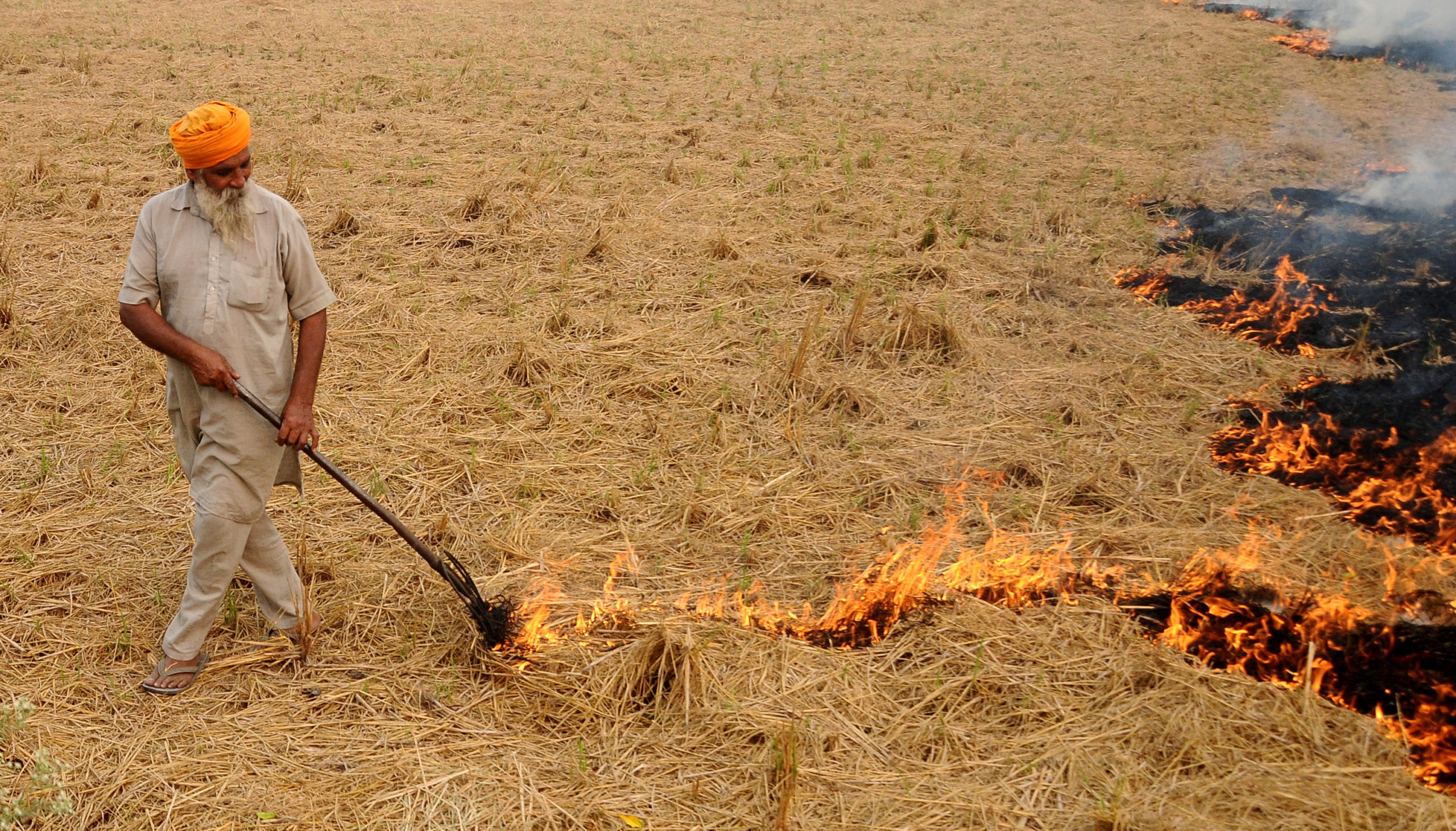Stubble burning in Punjab has annually been cited as the main contributor to the smog in Delhi and parts of northern India in pre-winter months. Delhi’s air quality levels in winter exacerbate respiratory problems and lead to disruption in air and road travel due to the poor visibility.
The Supreme Court in its last year’s November 4 order called it a shocking state of affairs and sought to incentivise small and medium farmers with a cash reward at the rate of Rs. 2400 per acre to curb stubble burning, apart from giving subsidies on the purchase of crop residue management machines. But things haven’t worked so smoothly on the ground.
Despite the longstanding ban on stubble burning, farmers who have already harvested the crop, have once again resorted to the burning of leftover crop residue (the stubble) in order to clear their fields for the next crop. Paddy harvesting is usually in full swing in the state from the first week of October and the sowing of the wheat crop begins in the last week of October.
The Punjab Remote Sensing Centre (PRSC), an autonomous government body situated in Ludhiana, which is keeping track of stubble burning cases in the state since 2014, has already recorded 2873 cases of stubble fires in different areas in the three weeks between September 21 and October 12. In the corresponding period last year, 755 cases were recorded and 510 cases in 2018, revealed the PRSC data.
Amritsar has been leading the chart with 1,111 fires followed by Taran Taran (655), Patiala (251), Gurdaspur (166), Ferozpur (115), Kapurthala (86) and Sangrur (81).

Anil Sood, a scientist at PRSC, told Mongabay-India that a majority of the latest stubble burning incidents were reported from Amritsar and Taran Taran districts, where sowing and harvesting of the paddy crop are usually more advanced than other districts.
“Farmers put the stubble on fire in order to prepare their fields for sowing potatoes and other vegetables. We have already sent the information to the Punjab Pollution Control Board (PPCB) and deputy commissioners of these areas to identify farmers involved in these firing incidents and to take penal action,” said Sood.
According to the data gathered from the Punjab Agriculture and Farmer Welfare department and PPCB, 52,942 farm fire incidents were reported in 2019 against 51,751 incidents in 2018. Sood said that it is hard to say if the overall situation improves this year given that the number of stubble burning cases reported so far is more than last year’s number.
On the other hand, PPCB secretary Krunesh Garg said that the period between end-October to mid-November will be crucial where maximum fire incidents take place. We have roped in all departments to monitor the fire incidents. So far, a penalty amounting to a total of Rs. 12 lakh has been imposed on 500 farmers, he said.
‘No cash incentive so far, big farmers enjoying subsided machines’
The Punjab government has claimed to have subsidised 23500 crop residue machines this year and appointed 8000 nodal officers to help farmers stop stubble burning. Meanwhile, farmers are claiming government support was insufficient and no cash incentive has reached small and medium farmers as directed by the Supreme Court last year.
Sutantar Kumar Airi, Director, Department of Agriculture and Farmer Welfare, Punjab Government, told Mongabay-India that the burning cases are being dealt with utmost urgency, with the nodal officers deployed to keep a check on stubble fires across the state.
He said as far as government support to the farmers is concerned, they provided more than 51000 crop residue machines to the state farmers with a subsidy of Rs. 500 crore in the last two paddy seasons. This season, another 23500 machines with Rs 200 crore subsidy are being provided.
Airi informed that subsidy is 50% of the total machine cost if it is individually purchased. If purchased in a group, the subsidy is as high as 80%. Farmers can register themselves with the industries department for buying agro machines in groups and then claim subsidy with the agriculture department, he said.
“But where is the cash incentive to the small and marginal [farmers] as promised by the Supreme Court,” questioned Jagmohan Singh, general secretary of Bhartiya Kisan Union (BKU), Dakunda. He said that only big farmers enjoyed these cash subsidies provided by the Punjab government for buying the crop residue machines. There were talks of providing these machines to small and medium farmers through cooperative societies but that has not happened.
He said the majority of the farmers who are small and don’t have big landholdings could not afford these machines on their own even at subsidised rates and hence, are now forced to burn the stubble in their fields like previous years.
“We all know the ill-effects of stubble burning and its damage to the environment. But what option do we have? Unless the farmers are compensated for the management of crop residue, they will continue to burn it,” added Jagmohan Singh.
Gurjeet Singh, a farmer from Ajnala near Amritsar, said that the cost of managing the stubble is close to Rs. 3000 per acre and that is the reason they are forced to burn it.
Punjab Government in February this year constituted a committee under Justice (retd) Metab Singh Gill who convened a meeting with all major farmers unions later that month to discuss the stubble burning issue. During the meeting, Justice Gill acknowledged the need to give cash subsidy to small and medium farmers to overcome this problem but not a single meeting was convened since then, said Jagmohan Singh of BKU Dhakunda.
Charanpal Singh Bagri, a counsel representing farmers in the Supreme Court (SC) said that the Punjab government told the SC bench last month that it had no funds to pay cash incentives to farmers to curb stubble burning, in light of the COVID-19 situation and sought the centre’s help to compensate the farmers. But the centre too refused to help in this matter.
“In such a situation, how fair is it to put the entire blame on farmers for stubble burning when there is no concrete plan to help them overcome the cost of managing the stubble that they can’t afford on their own due to their meagre resources,” he asked.
Bagri said that he too has been fighting in various courts against penalties being imposed on farmers for burning the stubble. Penalties range between Rs. 2500 to Rs 15000 per acre, with police cases against them. The practice began in 2015 under the direction of the National Green Tribunal.
As per the data from the Punjab Pollution Control Board (PPCB), penalties worth Rs. 40 lakh (Rs. 400,000) were levied last year on farmers burning stubble. However, how much of it was recovered is not clear, since different agencies at the local level are maintaining the data.
Sutantar Kumar Airi, Director, Agriculture, said they are trying their level best to arrange funds for the cash incentives to the farmers. A letter was recently written to the centre for additional funds. Till then, we can’t say if it can be paid, he added.
Burning in Haryana too
Meanwhile, Haryana, which also contributes to air pollution, although not at the scale as seen in Punjab, has reported 1200 cases of field fires between September 25 and October 12.
S. Narayanan, member secretary, Haryana Pollution Control Board said that last year, they had recorded 6700 stubble fire incidents. The per-day average cases reported this time is around 140 to 150. “This is not a very huge number but we are trying our level best to bring down the cases,” he said.
Of the cases received, Kurukshetra is leading the chart with 250 cases followed by 238 cases in Karnal, 172 cases in Ambala, 102 in Fatehabad and 90 in Jind.
He said the time between October end to November first week is very crucial. Everyone, including the agriculture department and local administration, has been doing a lot of awareness activities on the ground. They have also distributed eco-friendly crop residue machines as well.
Doctors say burning may aggravate COVID
According to the System of Air Quality and Weather Forecasting and Research (SAFAR), the Ministry of Earth Science, the last year’s stubble burning in Punjab as well as neighbouring Haryana had contributed to 44 percent of the pollution in the Delhi-National Capital Region.
But this year, the threat seems even bigger. Sanjeev Nagpal, who is an advisor to the union and the Punjab governments on crop residue management, said that if alternatives to stubble burning are not made available, pollutants like particulate matter (PM) and toxic gases could give rise to severe respiratory problems, which will further worsen the COVID-19 situation.

Dr. K.K. Talwar, who heads the Punjab Government’s expert group on COVID, too acknowledged the bad impact of stubble burning on the disease. He said that COVID-19 is well known to hit the respiratory system.
“If pollution level rises due to stubble burning as it is seen in previous years, it will create adverse conditions for respiratory or lungs related problems and end up aggravating the COVID problem in the affected persons,” said Talwar. “I am sure the government is taking all possible steps to keep it contained this year,” he said.
Dr. Digambar Behera, a leading doctor of pulmonary diseases from Chandigarh’s Post-Graduate Institute of Medical Education and Research (PGIMER), said that when air pollution like smog goes inside the body, it disturbs the lung function and cause problems like breathlessness. Then there is an acute deterioration in patients already suffering from problems like asthma. It is therefore dangerous both for normal persons or those with pre-existing diseases.
“We must try that such a situation does not arise. If it happens, the only solution for persons is to stay indoors and not get exposed to it. Once it happens, it may not only make COVID recoveries difficult but may also lead to more fatalities. It may also increase the patient load — those with chest ailments, including lung and breathing problems. That is not a healthy sign since our medical health system is already over pressurised due to COVID,” he said.
‘Focus on a viable commercial model to deal with stubble’: Experts
Punjab’s leading farm economist Sucha Singh Gill said that rather than subsiding crop residue machines or cash incentives to the farmers, the state government should focus on finding a viable commercial model to deal with the stubble problem. People don’t know but stubble is a precious raw material used to produce gas and other by-products in bio-gas plants.
He said, for instance, a German firm has set up two biogas plants in Lehragaga town of Sangrur district of Punjab and already started buying stubble from farmers at the rate of Rs 2500-3000 per acre. Similar plants have also been set up in Fazilka and Nawashehr areas.
“If we have 100 or 150 such plants, we will definitely overcome this problem. In fact, the state will have ample biogas or bio manure that can be used back into fields to improve the quality of the soil. Now with stubble burning not only soil health is being compromised, but the environment is also a major loss. It is definitely not a good sign especially when the whole country is struggling with COVID-19,” said Gill.
Vivek Gupta worked in several media outlets including The Hindustan Times, The Indian Express and The Tribune. Writer can be reached on Twitter at @guptavivek83.













